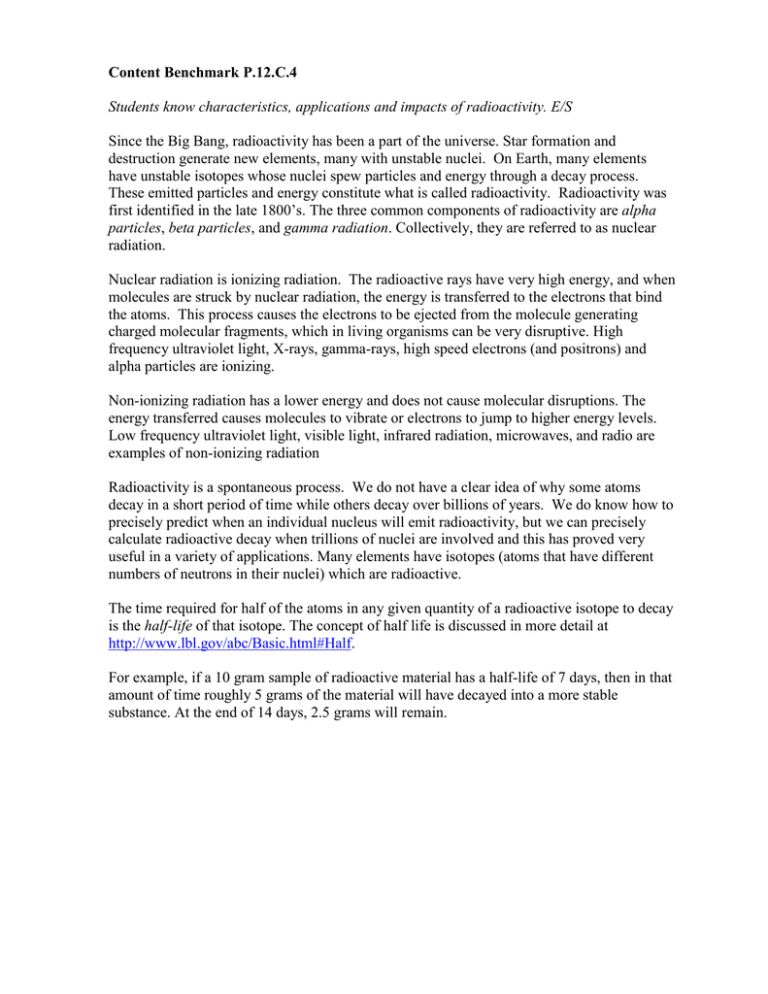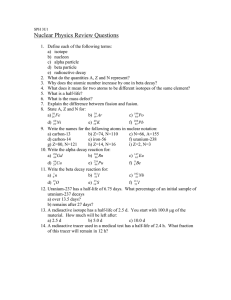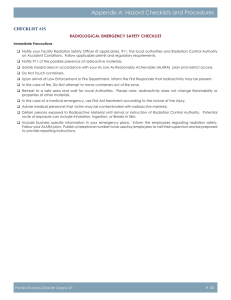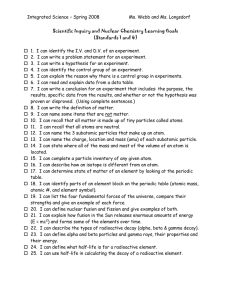Content Benchmark P.12.C.4
advertisement

Content Benchmark P.12.C.4 Students know characteristics, applications and impacts of radioactivity. E/S Since the Big Bang, radioactivity has been a part of the universe. Star formation and destruction generate new elements, many with unstable nuclei. On Earth, many elements have unstable isotopes whose nuclei spew particles and energy through a decay process. These emitted particles and energy constitute what is called radioactivity. Radioactivity was first identified in the late 1800’s. The three common components of radioactivity are alpha particles, beta particles, and gamma radiation. Collectively, they are referred to as nuclear radiation. Nuclear radiation is ionizing radiation. The radioactive rays have very high energy, and when molecules are struck by nuclear radiation, the energy is transferred to the electrons that bind the atoms. This process causes the electrons to be ejected from the molecule generating charged molecular fragments, which in living organisms can be very disruptive. High frequency ultraviolet light, X-rays, gamma-rays, high speed electrons (and positrons) and alpha particles are ionizing. Non-ionizing radiation has a lower energy and does not cause molecular disruptions. The energy transferred causes molecules to vibrate or electrons to jump to higher energy levels. Low frequency ultraviolet light, visible light, infrared radiation, microwaves, and radio are examples of non-ionizing radiation Radioactivity is a spontaneous process. We do not have a clear idea of why some atoms decay in a short period of time while others decay over billions of years. We do know how to precisely predict when an individual nucleus will emit radioactivity, but we can precisely calculate radioactive decay when trillions of nuclei are involved and this has proved very useful in a variety of applications. Many elements have isotopes (atoms that have different numbers of neutrons in their nuclei) which are radioactive. The time required for half of the atoms in any given quantity of a radioactive isotope to decay is the half-life of that isotope. The concept of half life is discussed in more detail at http://www.lbl.gov/abc/Basic.html#Half. For example, if a 10 gram sample of radioactive material has a half-life of 7 days, then in that amount of time roughly 5 grams of the material will have decayed into a more stable substance. At the end of 14 days, 2.5 grams will remain. Figure 1. Chart showing the decrease (decay) in radioactivity over time for Sodium-24, a concept called radioactive half-life. (from http://gcse.com/radio/images/halflife.gif) Ernest Rutherford demonstrated in 1899 that radioactivity consisted of at least two types of particles that he called alpha and beta rays. Later, a third type of ray was found and named gamma rays. Upon analysis, alpha particles were determined to be a positively charged helium nucleus with two neutrons in its nucleus. Beta particles were determined to be high speed electrons and gamma rays were very high frequency photons (higher in frequency than X-rays). Of the three, gamma rays have no mass, traveled the fastest (the speed of light), and were able to pass through most materials, except very dense lead. Beta particles were the second fastest of the three particles. Because beta particles are electrons, they have a very low mass and are negatively charged. Beta particles can pass through many materials, but are stopped by aluminum foil. Alpha particles, which are helium nuclei, are the heaviest of the three particles, stopped by most materials such a piece of paper, and travel the slowest. For more information please see http://www.accessexcellence.org/AE/AEC/CC/radio_slides.html. Figure 2. Penetrative characteristics of radioactive particles. (from http://www.ocrwm.doe.gov/factsheets/images/ymp0403graphics.htm) All unstable atomic nuclei undergo transformations that eventually stabilize their nuclei. These transformations involve radioactive decay and emission of alpha, beta, and/or gamma radiation. Most unstable nuclei require several decays in order to form a stable nucleus. Uranium is a good example of a multi-step decay series. Figure 3. The decay of naturally occurring uranium (U238) to lead. (from http://earthguide.ucsd.edu/virtualmuseum/images/Uraniu m238.html) Radiometric dating is one very important application of radioactivity. Carbon dating is used to determine the relative age of ancient artifacts. The radiocarbon method is based on the rate of decay of the radioactive or unstable carbon isotope 14 (14C), which is formed in the upper atmosphere through the effect of cosmic ray neutrons upon nitrogen 14. All living organisms contain radioactive carbon-14. When an organism dies, it no longer takes in any carbon at all. The amounts of carbon-14 slowly begin to decrease as the decay series begins. Using the half-life information about carbon-14 and its amount in the environment, the age of the organic material can be dated. The half-life of carbon-14 is 5730 years. The decay equation is as follows: Carbon-14 Nitrogen-14 + β It can be seen that carbon-14 decays back to nitrogen releasing a beta particle in the process. There is a quantitative relationship between the decay of carbon and the production of the beta particle. From this relationship the age of the artifact can be determined. For further information about carbon dating, go to http://www.c14dating.com/int.html. About 56% of the ionizing radiation we are exposed to comes from natural sources, with the two primary sources being cosmic rays and Earth minerals. Cosmic rays are comprised mostly of high speed protons emanating from space. When these protons interact with the atmospheric molecules, they can create secondary alpha, beta, and gamma radiation. Earth minerals contain many naturally occurring radioactive elements, such as radon (a radioactive element produced as naturally-occurring uranium decays). Almost all other human exposure (42%) ionizing radiation is caused by mental and dental Xrays. To learn more about human exposures to ionizing radiation, go to http://www.atsdr.cdc.gov/tfacts149.html Even though ionizing radiation is dangerous, it does benefit humans in many ways, such as diagnosing and fighting diseases. For example, cancer cells are destroyed by ionizing radiation, and food and water supplies are disinfected from disease-causing bacteria by using ionizing radiation. For more about the beneficial uses of radioactivity in medicine and other fields, go to http://www.pbs.org/newshour/forum/november96/nuclear_power.html. Wastes results from human uses of radioactivity. Understanding that radioactivity can be contained (e.g., alpha particles are stopped by paper, beta particles are stopped by aluminum, and gamma rays by lead or reinforced concrete) allows engineers to design canisters and other systems to effectively contain radioactive waste, preventing release into the environment. The repository at Yucca Mountain is a barrier system in which the radioactive spent nuclear fuel pellets (solids) are placed in steel canisters, which are in turn backfilled by bentonite clay, which are turn placed 300 m underground and 300 m above the water table. For more information about the Yucca Mountain Project, go to http://www.ocrwm.doe.gov/factsheets/doeymp0026.shtml. Content Benchmark P.12.C.4 Students know characteristics, applications and impacts of radioactivity. E/S Common misconceptions associated with this benchmark: 1. Students are confused about radioactive half-life, and incorrectly think that mass is reduced, the process is influenced externally, and/or decay rate can be controlled. These misconceptions may stem just from the term itself. There is also confusion with the word “decay” because students associate decay with “rotting” and “loss.” During the decay process, radioactive nuclei do not disappear but rather decay into more stable nuclei. Although some of the parent mass is converted to energy in the release of radioactivity, this amount is very small (i.e., not half). Also, while the parent material is converted to progeny material, the sum of the masses of parent and progeny are almost the same as the original mass. Also, external effects, such as environmental conditions or external energy sources do not increase or decrease the half-life of a substance. For example, radioactive decay of carbon-14 does not depend on the temperature of the material. External energy sources can result in nuclear fission or fusion reactions, which may release large quantities of radioactive material. However, the half-life of the materials created during fission and fusion reactions is independent of the external energy added. Finally, students can confuse chemical reactions, which involve electrons, and nuclear reactions, which involve the neutrons and protons. Because of this confusion, students may incorrectly think that half-life and radioactivity is a result of chemical reactions, rather than the correctly identifying them with nuclear. To learn more about half-life and other radioactivity misconceptions, go to http://www.jal.cc.il.us/~mikolajsawicki/ex_radio.html. 2. Students incorrectly believe that all radiation is harmful. Humans are continuously exposed to radiation both ionizing and non-ionizing. Much of this radiation is in the form of electromagnetic waves, which are commonly referred to as electromagnetic radiation (EMR). The Sun emits all frequencies of EMR, but most of this radiation is in the form of visible light. Ionizing radiation is most harmful to humans because it can damage interior cell structure, which in turn causes diseases such as cancer. Non-ionizing radiation, such as visible light, is typically not harmful. To learn more about EMR and naturally occurring radiation, go to http://www.ocrwm.doe.gov/factsheets/doeymp0403.shtml Content Benchmark P.12.C.4 Students know characteristics, applications and impacts of radioactivity. E/S Sample Test Questions 1. Which of the three types of ionizing radiation would be stopped by human skin? a. alpha only b. beta only c. gamma only d. both beta and gamma 2. Which of the three types of ionizing radiation would penetrate a textbook? a. alpha only b. beta only c. gamma only d. alpha, beta, and gamma 3. Which of the three types of ionizing radiation would be stopped by a thin piece paper? a. alpha only b. beta only c. gamma only d. both alpha and gamma 4. Which of the three types of ionizing radiation would be stopped by reinforced concrete? a. alpha only b. beta only c. gamma only d. alpha, beta, and gamma 5. Ionizing radiation is considered to be harmful because a. it cooks food quickly. b. it breaks chemical bonds. c. it is found in microwaves. d. it disinfects water. 6. Chlorine-37 is an isotope that emits radioactivity and has 17 protons. How many neutrons does it have? a. 17 b. 18 c. 20 d. 19 7. An isotope’s radioactive half-life is dependent upon a. the humidity of isotope’ environment. b. the temperature of isotope. c. the amount of sunlight reacting with the isotope. d. the nuclear composition of the isotope. 8. The half-life of carbon-14 is about 6000 years. After 12,000 years, about how much carbon-14 would remain in a sample? a. Half of the isotopes in the sample would be carbon-14 b. One-quarter of the isotopes in the sample would be carbon-14. c. Half of the sample mass would be carbon-14. d. All of the carbon-14 would have decayed. 9. Using the graph below, what is the half-life of Sodium-24? a. b. c. d. 15 hours 30 hours 45 hours 60 hours 10. Barrier shielding systems of radioactive waste repositories are designed to prevent release of radioactivity to the environment by a. shortening the waste material’s half-life. b. stopping terrorists from obtaining nuclear materials. c. absorbing ionizing radiation emitted by the waste. d. preventing farmers and ranchers from drilling into the waste. Content Benchmark P.12.C.4 Students know characteristics, applications and impacts of radioactivity. E/S Answers to Sample Test Questions 1. (a) 2. (c) 3. (a) 4. (d) 5. (b) 6. (c) 7. (d) 8. (b) 9. (a) 10. (c) Content Benchmark P.12.C.4 Students know characteristics, applications and impacts of radioactivity. E/S The following list of intervention strategies and resources will facilitate student understanding of this benchmark. 1. Radioactivity Background Information This site provides the student and the teacher with solid background information on radioactivity and can be found at http://www.darvill.clara.net/nucrad/. 2. Nuclear Medicine Information Sheet Radioactivity, Isotopes and Radioisotopes from Nature, Nuclear Reactors and Cyclotrons for use in Nuclear Medicine are discussed in this Web site maintained by the Australian government. To access this site, go to http://www.ansto.gov.au/info/reports/radboyd.html 3. Radioactive Decay Lesson Science NetLinks, a site created by the American Association for the Advancement of Science, has science content lessons that link to the Project 2061 Benchmarks. One lesson at this site concerns radioactive decay. This lesson is very popular with students because it involves the use of candy. To get this lesson, go to http://www.sciencenetlinks.com/lessons.cfm?BenchmarkID=4&DocID=178 4. Half Life Simulation The 7Stones Web site contains many lessons, activities, and simulations covering physics and chemistry. If computer access is available in the classroom, the site has an excellent simulation of radioactive decay. The simulation can be accessed at http://www.7stones.com/Homepage/Publisher/halfLife.html 5. Access Excellence Health Museum Information and Activities This site and its companion sites feature the contributions and research of four different scientists as they tried to understand the phenomenon of radioactivity. Background readings for student research are provided at the site. To access the site, go to http://www.accessexcellence.org/AE/AEC/CC/historical_background.html This website has an excellent student activity and simulation for teaching half-lives that can be found at http://www.accessexcellence.org/AE/AEPC/WWC/1995/teach_rad.html.




